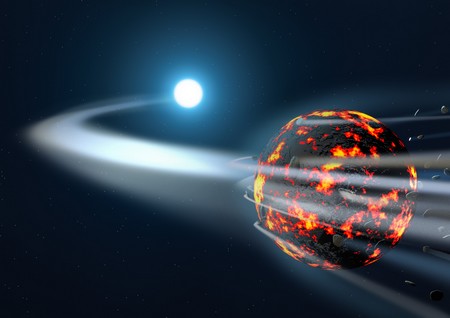'Vervuilde' witte dwergsterren laten zien dat sterren en planeten tegelijkertijd groeien
Waarnemingen en simulaties van 237 witte dwergsterren versterken het bewijs dat planeten en sterren snel samen ontstaan en uitgroeien tot planetenstelsels. Een internationaal team van astronomen en planetaire wetenschappers, onder wie Tim Lichtenberg van het Kapteyn Instituut van de Rijksuniversiteit Groningen, publiceerde hun bevindingen maandag in Nature Astronomy.
Planeten vormen zich rond een jonge ster in een schijf van waterstof, helium en kleine deeltjes ijs en stof. De stofdeeltjes klonteren samen en groeien eerst langzaam. Als er genoeg van die klonten bij elkaar zijn, kunnen zogeheten planetesimalen ontstaan, die vervolgens kunnen uitgroeien tot planeten. Eventuele brokstukken blijven achter als planetoïden of planetesimalen. Die kunnen af en toe nog inslaan op de ster en daarmee een soort fossiele afdruk achterlaten van vroege geologische processen.

Witte dwergen
Er is discussie onder astronomen en planetaire wetenschappers over de vraag of eerst een ster wordt gevormd en pas vele miljoenen jaren later de planeten, of dat de planeetvorming vrijwel gelijktijdig met de ster begint. Om die vraag te beantwoorden analyseerden de onderzoekers het licht uit de atmosfeer van 237 zogeheten vervuilde witte dwergen. Deze sterren aan het einde van hun leven worden “vervuild” genoemd omdat ze naast helium en waterstof ook zwaardere elementen zoals silicium, magnesium, ijzer, zuurstof, calcium, koolstof, chroom en nikkel in hun atmosfeer bevatten.
‘De verrijking met zware elementen duidt erop dat er planetesimalen met ijzeren kern op de ster zijn gevallen’, zegt Tim Lichtenberg, een van de auteurs van de studie. Hij werkte bij de Universiteit van Oxford toen het onderzoek begon en is nu werkzaam bij de Rijksuniversiteit Groningen. ‘En zo'n ijzeren kern kan eigenlijk alleen ontstaan als het brokstuk eerder fors is verwarmd. Dan worden ijzer, gesteente en meer vluchtige elementen namelijk van elkaar scheiden.’

Simulaties
Aanvullende simulaties van botsingen tussen planetoïden versterken de waarnemingen en laten zien dat de brokstukken die in de sterren vallen vrij klein moeten zijn. 'De ijzeren kernen zijn, net als bij planetoïden in ons eigen zonnestelsel, waarschijnlijk ontstaan door warmte die vrijkomt bij het verval van kortlevende radioactieve elementen', aldus Lichtenberg. 'We vermoeden dat het hier gaat om aluminium-26. Dat element zorgde ook voor de vorming van planeetkernen in ons eigen zonnestelsel.' Aluminium-26 heeft een halfwaardetijd van ongeveer 700.000 jaar. Mede daardoor stellen de onderzoekers dat de planeetvorming rond wat nu witte dwergsterren zijn, moet hebben plaatsgevonden in de eerste paar honderdduizend jaar van het sterrenleven.
In de toekomst willen de wetenschappers hun onderzoek aan vervuilde witte dwergen uitbreiden. De hoeveelheden nikkel en chroom in deze "hemelse begraafplaatsen" geven bijvoorbeeld informatie over hoe groot een planetoïde of planetesimaal was toen de ijzeren kern ontstond. En dat kan informatie leveren over de samenstelling van atmosferen van aardachtige exoplaneten.
Referentie: Amy Bonsor, Tim Lichtenberg, Joanna Drazkowska & Andrew M. Buchan: Rapid formation of exoplanetesimals revealed by white dwarfs, Nature Astronomy, 14 november 2022.
Tekst: NOVA
Meer nieuws
-
19 december 2025
Mariano Méndez ontvangt Argentijnse RAÍCES-prijs
-
18 december 2025
Waarom innoveren, en voor wie?
-
17 december 2025
Ben Feringa wint Feynmanprijs
